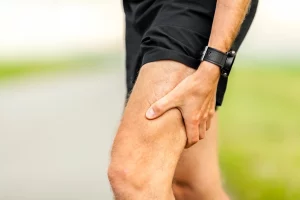In the last blog post, chartered physiotherapist & practicing clinician, David Fitzgerald, talked about the general causes, symptoms and treatments for low back pain.
This week, David focuses more on a specific cause of low back pain, facet joint pain, with symptoms that come from the so-called facet joints. These are a pair of joints located in each region of the spine; the cervical spine, the thoracis spine and the lumbar spine (low back region). These joints, located on either side of the vertebrae, are described as “guide rails” or, as David says, as a “three-legged stool”. The front part of the stool is the vertebrae – the main weight-bearing – while the two facet joints act as stabilizers at the back of each side, like the two legs of a three-legged stool.
What are the main functions of the facet joints?
Facet joints come in different shapes, located on different parts of the spine and they normally don’t take a lot of weight. They are, in fact just there to control the movements in our vertebrae.
Just like the other low back pathologies discussed in the previous video, there’s a wide spectrum of severity that varies from recurrent irritations to degenerative change and thickening of the tissue so, from a clinical point of view, it’s always better to identify where the patient is on that scale. This will help understand what’s the degree of reversibility of the problem and what are the challenges from a rehabilitation point of view. Dublin Physio is, in fact, one of the clinics offering great rehabilitation and physiotherapy services in Ireland and, thanks to the many years of expertise of David and Grainne McKeown, issues like this can be tackled very effectively.
What are the factors that lead to joints’ damage?
It’s not uncommon that the inflammation or damage to facet joints can be unilateral, meaning that only one side of the spine is affected. However, it is also possible that the facet joints on both sides get irritated at the same time.
One of the most common causes of facet joint overload and irritation is when the disc space begins to narrow. This could be a consequence of a disc prolapse and the most dominant symptom is usually the bulging of the disc, particularly if the bulging is putting pressure on a nerve. When this happens, the disc usually tends to become more squashed and compressed and, in the event of a disc compression, more pressure goes onto the two facet joints as well.
It’s also worth mentioning, however, that the disc base gradually narrows as a natural part of the aging process and, although this process is not necessarily painful, one of the consequences of disc narrowing could be irritated facet joints on one or both sides.
How to identify facent joints’ pain
Patients who are suffering from facet joint pain are usually able to be very specific when pointing to the source of their pain. These joints are located about an inch off to the side of the midline of the back, described by David as the “central bony bit of your spinal column”.
As it’s been said, people suffering from this are able to pinpoint the pain very specifically, however, when the joints are irritated, the muscles will be in spasm over the top and this can be commonly mistaken as another source of pain.
David gives a very specific tip to successfully identifying this issue; usually the hallmark is a sharp specific pain, aggravated by certain positions and often eased by changing position. Thanks to such easy-to-identify symptoms, facet joints pain is of the easiest conditions to diagnose and the only challenge is to understand on what scale of pain the patient is, how to act to alleviate their pain and what’s the right treatment for the condition. David goes on and explains what the other possible causes of facet joints pain are and what the possible treatments can be based on the gravity of the situation.
If you are in pain and want to identify the source, request a call back from Dublin Physio, where you can get an expert consultation and treatment.
Watch David’s video to get some detailed insights on symptoms, causes and treatment for facet joints pain and don’t forget to check out the previous posts about Low Back Pain and Coccyx Pain.




